
Ever since Fitbit entered the market with their activity trackers, people have turned to gadgets for motivation, instruction and feedback in pursuit of living healthier lifestyles. So when I first got the Pip I thought it should work like a Fitbit – I carry it around and it does something to remind me to chill if I get to hot under the collar. I quickly discovered that the Pip and the Fitbit have very different goals. The success of the Fitbit wearable is due, in part, to the fact that it encourages the owner to achieve a SMART goal. SMART is an acronym for Specific (walking), Measurable (steps), Assignable (the wearer), Realistic (10,000) and Time-related (per day). Many people wear the Fitbit on their wrist to remind them to walk and find that without it they are much less motivated (just ask David Sedaris). In contrast, the Pip is a tool for learning how to fundamentally change your awareness and elimination of stress, and ultimately without the guidance that the Pip provides. It contributes to this behavioral change by providing feedback while practicing short meditative sessions. This type of cognitive behavioral therapy takes practice and can’t be appreciated in a day or two. I’ve been using it for about 3 weeks. Read on to see what I think!
Unboxing
The Pip comes in a small cardboard box with a white sleeve that is embossed with silhouettes of serene images. I’m relaxed already….
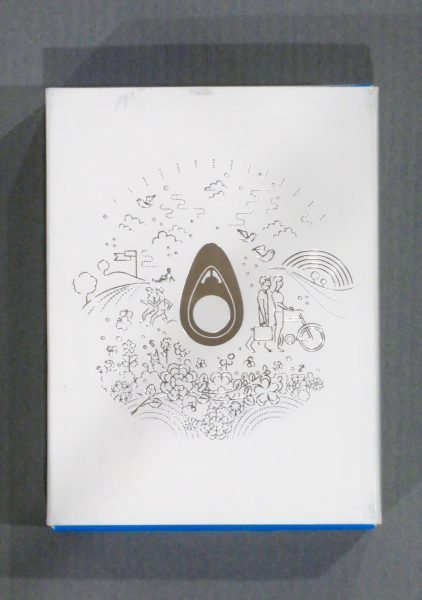
Inside the sleeve is a blue box with an image of the Pip on the cover. Opening the box reveals the Pip in a cardboard insert. Below the insert is a get started guide, a USB cable, a carrying pouch and a warranty card. The unit comes without an AC adapter for USB charging. Instead of providing an adapter for each region or a universal adapter, The Pip has decided to forgo shipping one altogether. I think this makes sense; I have a whole drawer of adapters from other gadgets I don’t use.
There is a 7 day user guide that The Pip has on their website that was not included in the package but absolutely should be. It can be accessed here.
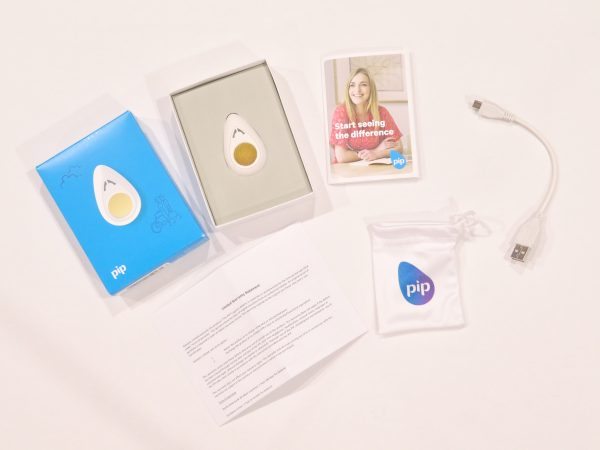
Hardware
The Pip is 2.1 x 1.3 x 0.6 inches, weighs 16 grams, and is shaped like a teardrop. The build quality is very good; even though this is an entire assembly of electrodes and electronics, it feels like a single solid piece of plastic.
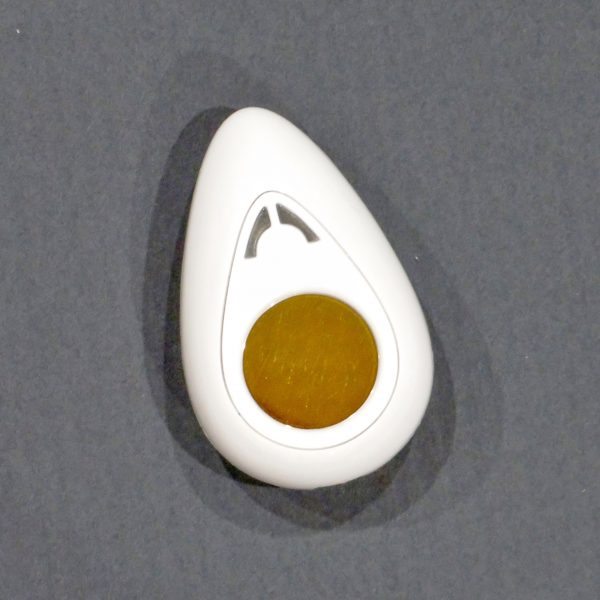
Here’s another view. The contacts on each side are gold plated to prevent them from tarnishing after prolonged and repeated contact. Each one is the size of a penny. When the Pip is turned on the left LED glows green. The LED on the right, not illuminated in the picture below, will glow red when the battery is low and will stay lit while charging. After receiving a full charge the red LED on the right will turn off.
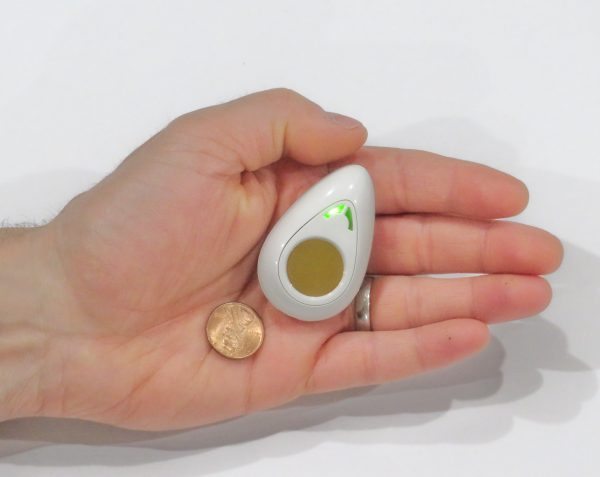
The Pip is designed to be held between the index finger and thumb, as in the picture below. The Pip turns on automatically when it receives a good signal from the user and turns off either by command from a paired device or after being left idle for a few minutes.
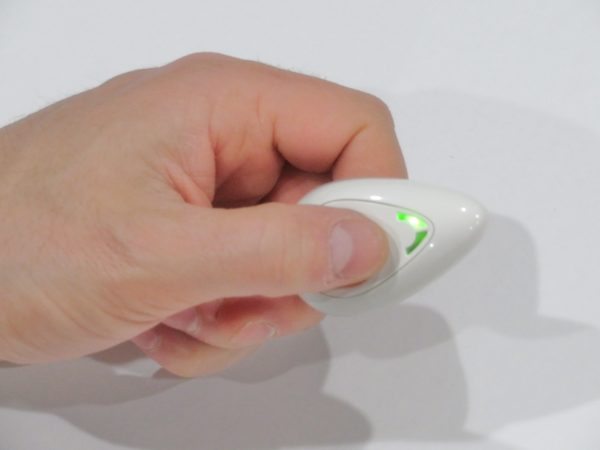
The rear of the unit is where the microUSB port is located for charging.
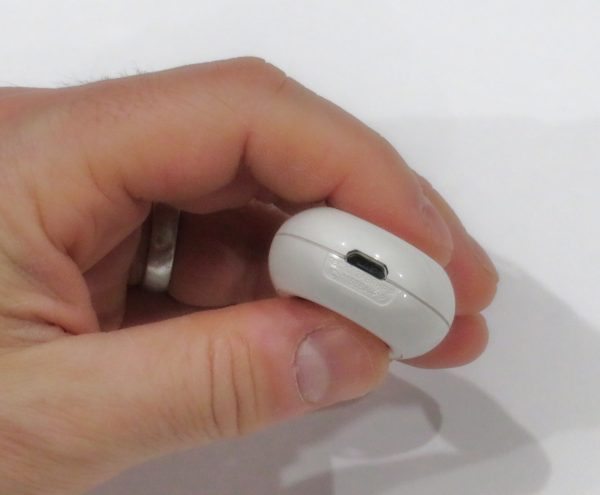
The design is simple to the point that it’s not completely obvious what the Pip is or how it functions. The Pip is a device to measure electrodermal activity (EDA). There is a direct but not so obvious connection between EDA and stress. In order to understand how stress can be measured we must first understand the physiology of the autonomic nervous system (ANS) and the way that the sympathetic and parasympathetic systems function to regulate metabolism. The parasympathetic nervous system is associated with conserving and restoring metabolic functions while the sympathetic nervous system utilizes metabolic functions to react to stress. The common activities of the sympathetic nervous system include elevated heart rate, increased blood pressure, increased blood flow to the muscles and brain, and perspiration. The filling of sweat ducts (with the conductive electrolyte we commonly refer to as sweat) only occurs by action of the sympathetic nervous system and lowers the resistance of the skin to an applied current. By measuring changes in the flow of a microscopic current applied to the skin, referred to as electrodermal activity (EDA), the Pip can measure the state of sympathetic nervous system activation and hence the presence of stress.
Because the surface area of contact and the relative conductance of sweat may vary over time and even within the same testing session, the measured current or resistance is not reported; only the relative change of the EDA is important. Thus, the Pip only reports three states of activity: Stress Events – indicate a short term increase in EDA, Relax Events – indicate a short term reduction in EDA, and Steady Events – indicate that you are neither stressing nor relaxing.
Software
The Pip only functions with applications developed by Galvanic, the manufacturer of the Pip. There are 5 apps in the Apple App Store. I found that each application worked well. I did not experience any bugs or crashes while using the apps on an iPhone 6 running 9.3.2.
Clarity is an audio feedback app which includes guided relaxation exercises. The audio feedback is an important part of this app and headphones or a quiet secluded place is recommended while practicing with it. There is an unguided mode and three guided modes that provide instruction before and after the feedback session. The guided modes are illustrated in the video below. Note that during the session, the color of the dots that surround the countdown timer represent the level of stress that is measured during that period of the session. There are three soundscapes to choose from: a forest rainstorm, waves breaking on a beach, and a park bench. As the stress states change the volume of the soundscapes increases or decreases to represent the trend of DA events.
The Loom is an audio and visual feedback App: this means that the number of Stress, Relax and Steady events will trigger visual and audible changes to animated landscapes displayed during your Pip session. The duration of a Loom session depends on your stress level; the more you relax, the quicker the landscape will change. The app features 3 landscapes: a winter landscape transforms into springtime, a sunrise occurs over a mountain vista, and a forest changes from a moonlit to a sunlight filled scene. The first of the movies below is edited and cuts out a few minutes in the middle of the transformation. Also in the video below, you can see how the app pauses if the Pip isn’t held tightly enough.
Relax & Race teaches you how to stay calm and focused when faced with a stressful situation. It does this by placing you in an artificially stressful situation – a race, where you can practice different stress management techniques and identify which one works best at helping you stay calm even when there is a desire to perform under pressure. There are three different scene you can choose from in the app: a dragon race, a balloon race, and a underwater race. To me, the imagery wasn’t as significant as the fact that I was trying to race while still remaining calm. Note that there is also a two player mode so that if you are with someone else who also has a Pip you can race staying calm together. If you’re alone then you can race against your previous best time or the average time of your sessions.
The Stress Tracker app provides visual feedback on your changing stress levels. The screen shows a line graph of your changing stress level and the words relaxed and stressed change size in response to your changing EDA. This app has no accompanying music, no visual imagery, no tasks to achieve or accomplish. It is just a tool to record how your EDA changes over a preset time; from 2 to 20 minutes. Once you have become aware of the techniques presented in the other apps then you can try them using this app and see how you perform. Once you have mastered the techniques with the Pip you should be able to incorporate them into your daily life without requiring the feedback the Pip provides.
Four Steps To Mindfulness is an app that incorporates Dr. Jeffrey Schwartz’s Four Steps to Mindfulness process. The app is a springboard to his program that includes video tutorials that explain how to use the process. The app uses The Loom winter to springtime tree imagery to help you refocus attention. Some of the content of this app has been incorporated into the other four. The session information on this app does not communicate with the cloud-based service “my Pip”
My Pip is a cloud based service that records the results of your sessions from all of the apps except the Four Steps to Mindfulness. The web records the total number of sessions, the total duration of your sessions, the most recent scores from each of the applications, the averaged number of events and detailed information from each app. Other information is included as well. The averages can be based on all time, the past 30 days or the past week. There is, in short, a whole host of information for appreciating your progress.
Summary
When I started this review I wasn’t a regular practitioner of meditation or mindfulness, although I was aware of some of the tenants of each and was receptive to giving it a try. I think that this is a prerequisite of using the Pip. If you listen to the guided materials for the Clarity app and think, “this is silly! I’m never going to do this!” then the Pip is probably not for you. On the other hand, if you already practice meditation then you are probably already aware of how it affects your mind and body and the Pip may not be needed by you either. I think that this is the perfect device for those of us in the middle ground. Also, because this device provides immediate observable feedback of how your body state changes after performing stress reducing activities, this is the perfect way to ascertain how these activities may lower your stress level.
I think the turning point for me came when I was stuck in traffic on the way to a meeting and I noticed how stressed my body was. Instead of fretting about it I just remembered to control my breathing and lowered my stress. (without the Pip, of course. I wouldn’t recommend using it while driving!) Using the Pip can help you appreciate your stress level and proactively improve it. Eventually you’ll be able to sense and improve your stress level without the Pip.
The Pip costs $179.00, which is probably the cost of an hour with a therapist or psychologist or 3 hours of massage. So the cost is relative to your expectations of what you plan to commit to relieving stress in your everyday life. Considering the Pip may be used over the long term, the price point for this device may be right where it should be.
Source: The sample for this review was provided by The Pip. Please visit their site for more info and Amazon to order.
Gerber Gear 22-47162N Fast Draw Folding Assisted Opening Pocket Knife, Fine Edge, Black
$40.60 (as of November 28, 2025 17:54 GMT -05:00 - More infoProduct prices and availability are accurate as of the date/time indicated and are subject to change. Any price and availability information displayed on [relevant Amazon Site(s), as applicable] at the time of purchase will apply to the purchase of this product.)Gerber Gear EVO Jr. Folding Knife - Serrated Edge [22-41493]
$28.99 (as of November 28, 2025 17:54 GMT -05:00 - More infoProduct prices and availability are accurate as of the date/time indicated and are subject to change. Any price and availability information displayed on [relevant Amazon Site(s), as applicable] at the time of purchase will apply to the purchase of this product.)Product Information
| Price: | $179.00 |
| Manufacturer: | Galvanic |
| Retailer: | Amazon |
| Requirements: |
|
| Pros: |
|
| Cons: |
|




Gadgeteer Comment Policy - Please read before commenting
Sounds like an interesting product … might have to review it for my blog too!
Considering that GSR (galvanic skin response) is already discredited in the context of lie detectors I find it hard to believe it can tell anything about one’s state.
And considering that we’re finding out now that the best known tracker – Fitbit – accuracy is seriously under skepticism you wonder how a little company could produce a reliable product. I think the Gadgeteer needs to be a little more skeptical in their announcement of gadgets.
Alan, I was skeptical at first too, but there happens to be a whole book ( W. Boucsein, Electrodermal Activity. New York: Plenum, 1992.) as well as years of peer reviewed, scientific journals that correlate stress, the Sympathetic Nervous System, and EDA. From thousands of hours of testing there is no evidence to the contrary that the nerves to the sweat glands and the skin blood vessels are from the sympathetic nervous system. Granted, there are certain situations which may cause activation of the Sympathetic Nervous System that are unrelated to stress (e.g. sexual excitement), but I figure most people don’t need a device to clue them into those feelings.
With regard to the size of the company and the reliability of the product, I believe apple was started by 3 people in 1976.